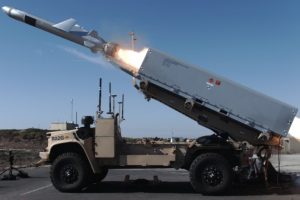Commandant of the Marine Corps David Berger last week outlined several areas he is focusing on through his Force Design 2030 effort and budget planning and called a new ground-based anti-ship missile capability the service’s top priority in the FY 2022 budget.
Speaking during the annual McAleese Defense Programs Conference May 13, he said the main focus of the Force Design is to help the Navy deter a fight with China while also helping it compete on a daily basis in competition in the gray zone.
Berger said China is “eating our lunch” in gray zone competition and “part of that is because they play by a different set of rules. They’re blurring the lines between police forces and coast guard and military and politics. They are blurring that intentionally. We have very clear lanes that we stay in and we haven’t moved off of that. We have not adjusted. We have to.”

The service must shift from how it fought in ground wars in Iraq and Afghanistan because “in our opinion, it’s no longer helping the fleet or the larger joint force deter, nor is it really designed for the types of gray zone competition that folks are writing and speaking about today that’s more commonplace. To put it bluntly: we’re too big, we’re too heavy, we’re not expeditionary, we’re too concentrated in certain areas of the globe and at certain sites that really lack resilience. We’re ground-centric,” Berger continued.
The commandant said the Marine Corps must reorient from a ground and land forces sustainment mode to a naval expeditionary maritime mode with littoral warfare and focusing on how to support the Navy and fleet commander in missions like anti-surface and even subsurface warfare.
“It means building a force that will contribute to what the Navy and us call sea denial and sea control. What is our role in that? And how do we sanitize a strait? How do we control a strait? The key maritime avenues that the nation needs kept open and our partners and allies need kept open. I think that naval orientation is clearly driving our investments in things like long-range precision fires, things like Light Amphibious Warships.”
Berger said these are capabilities the Marine Corps needs to support the fleet commander.
“We need less tanks, we need less short-range towed artillery, which suited our needs prior, [but] not a good match for what we need to do going forward.”
To that end, Berger highlighted progress on the new ground-based anti-ship missile, which he called the Marine Corps’ “number one priority” in the FY 2022 budget.
In April, Raytheon Technologies [RTX] revealed an image of the successful live fire test of a Naval Strike Missile fired from a Naval Marine Expeditionary Ship Interdiction System using a modified Joint Light Tactical Vehicle (Defense Daily, April 30).
Berger said the effort was two to three years in the making since some people from Marine Corps Systems Command and engineers came up with the capability.
“The end result is you take the top off of a Joint Light Tactical Vehicle, you make it remote controlled or autonomous, you put a [multiple launch rocket] on the back of it that can elevate, put a Naval Strike Missile in there, and now you have a capability which we demonstrated recently off the coast of California, sinking a moving ship. Okay, this is where we’ve got to go, at that kind of speed.”
Berger said this missile capability counts as conventional deterrence because it makes an adversary think twice.
Berger also said the force must be lighter, more mobile and more expeditionary. To that end, Marines must be able to operate from a diverse set of maritime platforms. He named T-AGOS-type ships, corvettes and frigates. “You name it, we should be comfortable operating from those ships.”
He said the Light Amphibious Warship (LAW) will give the Marine Corps “the organic mobility that we so desperately need in the littorals, anywhere in the world. Because if you don’t have it organically and you have to bring it from the outside, it’s going to be tough.”
A third focus for him is making the force more resilient and survivable.
“I would separate that from what some people think of as being invisible or I can’t be detected. That’s not the only way to be survivable. Centerpiece here I would say is Marine Littoral Regiments [MLR]”

The LAW is intended to support the MLRs.
Berger said these smaller, more distributed, more dispersed and maneuverable teams will operate every day inside an adversary’s weapon engagement zone. They will feature a “small footprint, mobile, can operate from a ship or from ashore, light logistical footprint.”
However, the commandant said the service needs help from industry in developing the technology to logistically support this kind of distributed force.
“In other words, of all the things that we’re working on in the naval force and narrowly within the Marine Corps, this is the hardest problem, I think, going forward. This is the logistical sustainment in a distributed environment in a contested environment. How do you do that? Because nobody has challenged our supply lines for 70 years.”
Berger’s final focus for the future force is on unmanned systems, with an increasingly prominent role going forward.
“We’re doubling the inventory of our unmanned aerial squadrons, UAS squadrons. Why? So that we can compete and beat the adversary in that sort of what we call reconnaissance/counter-reconnaissance competition.”
Berger said this will include a range of vessels including big wing medium-altitude long-endurance aircraft down to tactical longer-range unmanned aircraft systems that can fly off of Navy and Marine Corps ships.
He also highlighted “future platforms I think designed intentionally for undersea warfare, carrying everything from weapons systems, sonobuoys, everything, sensor packages. And I think as we experiment/wargame, we’re going to learn a lot about how we re-imagine capabilities going forward.”
Berger said the service has done much work to already self-fund these kinds of changes ahead of asking Congress for additional funds.
“We’ve shrunk the size of our headquarters by 15 percent. We’ve cut legacy programs with the support of Congress. We’ve squeezed everything we can, so that when it’s time to ask Congress for assistance, their support, I am confident we’ve wrung every bit efficiency out of our organization up front and no asked for a dollar more.”